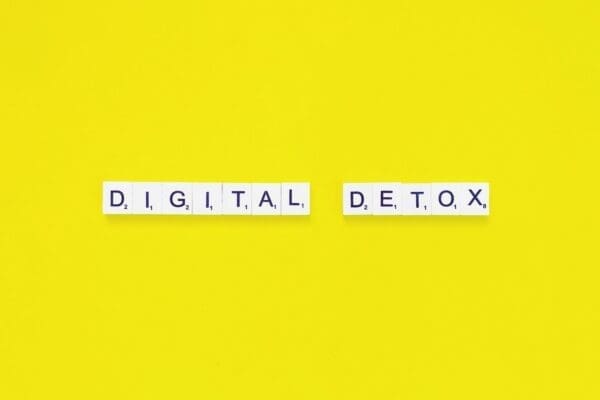Making Business People-Focused
Change management models play a key role in helping businesses design, plan and implement change and make their vision a reality. However, bosses’ duty of care for employees can get overlooked when their attention is focused elsewhere. Based on psychological insights, change management models help safeguard your staff’s well-being in these challenging times.
Change can be disruptive for any team. However, the level of disruption that is felt is minimised by applying change management models. Now this article explores some popular change management models people find helpful. We will look at what these models focus on and how they work.
Also, we will look at each in a non-biased way. Therefore, we will look at the pros and cons of each to ensure we know the strengths and potential gaps for each model. That way, you will be better able to apply the different models in more effective ways.
Change Management Models for You
To start, change can be impacted in a number of different ways using these models. So we have chosen 10 to review for you. We will cover an overview of each model, as well as the advantages and disadvantages of each. That way, you will have a better idea of which model will suit your leadership approach to change.
- McKinsey’s 7-S Framework
- Bridges’ Transition
- Scott and Jaffe’s Change Model
- David Rock’s SCARF Model
- Lewin’s Unfreeze-Change-Refreeze”
- Jeff Hiatt’s AKDAR
- Von Thun’s Communication Square
- Maslow’s Hierarchy of Needs
- Kotter’s 8-Step Change Management Model
- Maurer 3 Levels of Resistance and Change Model
As we look at each model, keep the following in mind. Imagine how you could apply each model. Also, think about which approach will best suit your needs. Additionally, keep your team in mind for each possible approach. All in all, these guidelines will help you decide which is the best fit for your current needs.
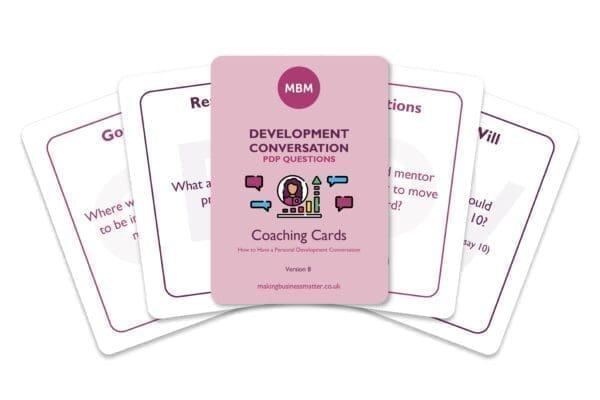
>> Development Conversation Cards <<
>> Access on Amazon <<
Importance of Change Management Models
Before we look at the different change management models, let’s first consider why these models are important. Usually, the leadership team decides and manages change in the company. Then, the team is expected to simply accept and comply with the change. However, speaking from experience, that is rarely how it works. Instead, we see different reactions and responses to change. As leaders, we need to address these challenges.
Now there are a number of reasons why leaders need to know and use a variety of models that are available. By using change management models we can:
- Increase the effectiveness of change.
- Reduce resistance to the changes
- Achieve change-focused goals more efficiently.
- Create a direction to achieve goals and targets.
- Measure success.
- Prepare for potential obstacles and barriers.
- And lastly, assist our team in adapting to the change more effectively.
Without these benefits in mind, we may ignore the importance of knowing and using these models for better results. Avoid falling into this trap by knowing the benefits and keeping them in mind. Also, consider all possible scenarios fully before applying a particular model. Use your understanding of your team and the required change to make good choices.
Model #1: McKinsey’s 7-S Model

Firstly, the McKinsey 7-S framework is a strategic tool that shows how the different aspects of a business interlink in corporate planning. Significantly, for this consideration of what makes for good practice in change management, the staff members come last on the list.
- Strategy: Competitive edge and market share.
- Structure: Leadership and employee configuration and responsibilities.
- Systems: Company policies, procedures, workflow and decisions.
- Shared values: Culture, vision and accepted behaviour in the workplace.
- Skills: Talents and capabilities of the leadership, management and team.
- Style: How the management leads the business and how it affects performance, productivity and corporate culture.
- Staff: Who the people are, their motivation and their ability to carry out the task.
Clearly, there are serious implications, that need to be addressed, if the employees are the last priority. Use this model when you need a detailed overview of all aspects of the company for the expected change process.
However, look at using other options to have a greater focus on the people in the company and the impact change will have on them. Otherwise, you run the risk of creating a great change process with little impact due to the reactions and responses of your team to the change.
Sticky Learning ® is 7 times more effective than 1-day training courses. Plus, you will get a Chain of Evidence proving your Return on Investment. Discover soft skills training that changes behaviours long term.

Advantages and Disadvantages
The main benefits of the model are:
- Analyse the potential impact of the required change.
- Break down the forecasted action for each area during the change process.
The barriers you may face are:
- Here, only the internal factors are really analysed.
- Also, it can take a lot of time to analyse each of the 7 areas within the organisation.
- Moreover, the results can be biased based on who is conducting the analysis.
Model #2: Bridges’ Transition
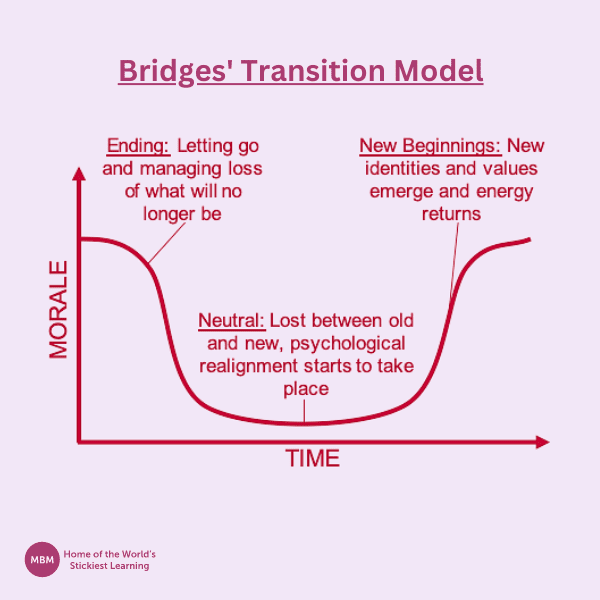
Developed by William Bridges, an American transition management expert, this model focuses on the psychological transition people go through as they internalise change and come to terms with it. The Bridges model has three stages:
- Endings: First, people identify what they are losing, and learn how to manage these losses. They determine what is over and being left behind, and what they will keep. Here, let go of the past. Instead, accept the possibilities that change can bring.
- The neutral zone: Next, the old way of working is gone, but the new one isn’t fully operational yet. This is when the psychological realignments and re-patterning happen. People are creating new processes and learning what their new roles will be. Therefore, they are in flux and may feel confusion and distress. Don’t remain in limbo for too long. Avoid getting stuck here in the middle between old and new. instead, move on to the next step as soon as possible.
- New beginnings: Then, this stage is marked by a burst of energy, going in a new direction. Employees feel a new sense of identity. Well-managed transitions allow people to establish new roles, with an understanding of their purpose. They know the part they play and how to contribute and participate effectively. And as a result, they feel reoriented and renewed.
So, this model is simplistic in its approach of 3 steps. However, look at each of these stages in detail. Take the time to review each of the stages. Consider each stage in depth by adding extra layers, where possible. Then, try to move to step 3 with as much ease as possible due to proper planning and analysis.
Advantages and Disadvantages
With this model, we can see the following.
Potential Strengths
- First, plan and prepare effectively for the emotional responses to change.
- Next, use this with ease by applying just the 3 stages mentioned.
Possible Challenges
- Be flexible knowing that different people will be at different stages at different times.
- Understand that the stages don’t fully explore every aspect required to make the change, focusing on the emotional aspects only.
Model #3: Scott and Jaffe’s Change Model
Next, Cynthia Scott and Dennis Jaffe explained the psychology of change in their article “Survive and Thrive In Times Of Change.” They took their inspiration from Elizabeth Kubler-Ross, who highlighted the ways people cope with tragedies, grief or sorrow.
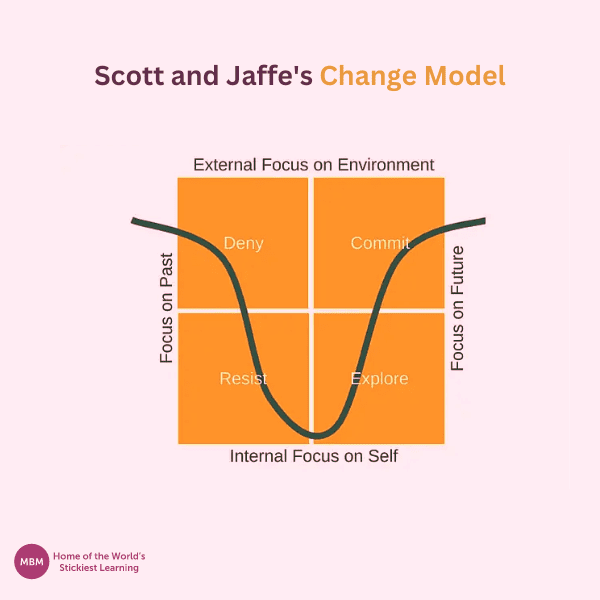
These ways are anger, denial, depression, bargaining and acceptance. It might sound melodramatic, but Scott and Jaffe describe the psychological process of change in a similar way:
- Denial: The feeling of change doesn’t sink in easily, and we try to ignore it.
- Resistance: We understand the change has happened, but we don’t accept it. We feel strong emotions and sometimes oppose them vocally. In a business, productivity suffers and the business loses stability.
- Exploration: We build up our coping or adaptive mechanisms and we try out new processes.
- Commitment: We feel re-empowered and happy to accept the new situation. Recognition of the commitment is important.
Here, change happens over time, moving from focusing on the past to focusing on the future. As time passes, people move from focusing on the outside world to becoming introspective and from there, refocusing on the outside world. Therefore, they go from feeling disempowered to feeling empowered once again.
Therefore, for change to happen in our companies, we need a similar outlook. Imagine, you have a big process you need to change to be more efficient and make more revenue. However, many of your team have been with the company for many years. They know the old procedures and are happy with how things work.
Now, picture how different members of your team might react when they hear about these changes. Then, think about how you, as the leader, would manage that. This model helps you plan for those scenarios.
Advantages and Disadvantages
Positive Impacts:
- Offers insights into how to manage change by minimising resistance to it.
- Provides a useful guide in terms of anticipating stages of change that will occur.
Negative Possibilities:
- Here, the results of the analysis may not reflect individual reactions to change within the team.
- Also, this 4-stage model may be overly simplistic in its approach, not taking all external factors into consideration.
Model #4: David Rock’s SCARF Model

So, your work is changing. How does that make you feel? We are evolved mammals, programmed to seek security and attachment. Neuroscience shows that our brains classify everything with a “reward” or “threat” feeling in our bodies. Therefore, we know how to move away from perceived threats and towards rewards.
So, with change, our brains want to know, is this good for us, or bad for us? Consider the positives that come along with change when considering your process for implementation.
Often, in their communication about change, leaders need to be mindful of areas where they can trigger their people. As defined by psychologist David Rock, the SCARF model helps people recognise their triggers in times of change. Rock identified five areas of human social experience:
- Status: Where we are in relation to others around us.
- Certainty: Being able to predict the future.
- Autonomy: Having control over events.
- Relatedness: A sense of safety with others, of a friend rather than a foe.
- Fairness: A perception of impartial and just exchanges with people.
Usually, people react very differently to stressful situations. In the reward state, we have more cognitive resources available. We think better and have more insights and ideas. We make fewer mistakes. In the threat state, we don’t think so well. We err on the safe side and become more defensive.
Advantages and Disadvantages
Strengths:
- Use the SCARF model and understand your team and how they tick, therefore avoiding future conflict.
- The model allows everyone involved to better adapt their behaviour through better awareness of the 5 triggers.
Limitations:
- Humans are implementing the change, therefore, human error in terms of approach can happen, increasing potential threats.
- Multiple threats at the same time limit the possibility of maximising the reward elements of the model.
Model #5: Lewin’s ‘Unfreeze-Change-Refreeze’

Next, we have Dr. Kurt Lewin who was a German-American psychologist, and one of the great pioneers of social, organisational and applied psychology. He is best known for identifying three leadership styles, democratic, autocratic and laissez-faire. But he also came up with this model of leadership and employee involvement in organisational change:
- Unfreeze: Because many people will naturally resist change, the goal here is to create awareness of how the old ways are hindering progress. From there you show them how the proposed change is necessary. In essence, the more we know about a change and how necessary it is to accept it, the more motivated we become.
- Change: Now people are ‘unfrozen,’ they can begin to move. The changing step, also known as transitioning or moving, is marked by the implementation of the change. This is when the change becomes real. It’s also when people struggle with the new reality. This period is the hardest stage to get through because there is such uncertainty. People begin to learn new behaviours, processes and ways of thinking. And the more prepared they are, the easier it is to go through with it. This is why training, communication, support and time are critical, as employees become familiar with the change.
- Refreeze: The change becomes reinforced, stabilised and set in place. The changes you make to processes, goals, structure and so on are accepted and re-frozen as the new status quo.
Advantages and Disadvantages
Potential Positives:
- Clarity of the unfreeze-refreeze image is a memorable way to visualise the change process.
- Again, a simple 3-stage model that is easy to apply, rather than more detailed processes.
Potential Negatives:
- Some critics argue that Lewin’s model isn’t detailed enough for proper change to occur.
- Others believe it doesn’t reflect today’s reality because businesses go on changing and evolving.
Model #6: Jeff Hiatt’s AKDAR

Often, step models and acronyms are helpful when we need to get to grips with new learning. Jeff Hiatt, founder of the change management specialists Prosci, developed AKDAR after studying over 700 businesses’ change patterns. It’s a powerful tool for helping individuals cope and plan for the change process.
‘AKDAR’ is an acronym for the five outcomes an individual needs to achieve, for a change to be successful. These are:
- Awareness of the need to change.
- Desire to support the change.
- Knowledge of how to make the change.
- Ability to demonstrate the skills and behaviours necessary to achieve the change.
- Reinforcement to make the change stick.
I have personally used AKDAR for change processes in the past. I can make the following recommendations for this model to work well.
First, include your team. Drive the change you expect to see through them. Therefore, listen to their ideas and thoughts for each section. Next, write out a plan that is visible. This way, people can refer back to review the different stages. Then, review the process as you roll out the changes. Adjust your plan as required. Finally, do not overlook the last stage. Avoid falling back into old habits that hamper your change goals.
Advantages and Disadvantages
Positive Aspects:
- Use for all sizes of teams and companies.
- Apply the stages straight away after working with the team.
Common Challenges:
- This model does not properly explore the emotional impact on the team.
- Some companies may find the process too complex and would prefer one of the shorter options.
Model #7: Von Thun’s Communication Square

Remember, leading others through change needs many different skills. One of these is effective communication. How you tell people about a proposed change, and how they take it in, can create serious misunderstandings. Friedemann Schulz von Thun identified four levels of response that happen simultaneously when we hear something that affects us:
- Factual level: We can’t help challenging supporting statements, like data and facts from external sources. Is what I’m being told true, relevant or complete?
- Self-revealing level: What am I hearing, and why am I being told this? Listeners think about what the person leading the change wants them to receive, as well as the information they DON’T want them to receive.
- Relationship level: How the person presenting the change gets along with the people hearing about it. impacts how they receive it.
- Appeal level: How do you feel about what the sender wants you to do in the change? Do you want to go along with it? Will you benefit? Do you feel you’re being manipulated or coerced?
Here, consider Von Thun’s different levels as you talk to team members and discuss proposals for change. Also, acknowledge the feelings of those involved in the change process. Then, address any concerns so that barriers can be overcome and you can proceed more smoothly.
Advantages and Disadvantages
Positive Impacts:
- Focus on the importance of communication for making change happen.
- Reflect on the emotional impact change can have on people.
Negative Consequences:
- Unfortunately, the model is limited to the communication aspect of change and not necessarily the action required after that point.
Model #8: Maslow’s Hierarchy of Needs

Click the image above for a larger version:
Change management models reflect many different aspects that everyone involved needs to be more aware of for change to happen. One point to keep in mind is that people need to feel fulfilled in their work. Going back to Scott and Jaffe, they definitely don’t want to feel threatened! How people welcome a change depends on how the new situation impacts their different levels of need, as identified in Maslow’s Hierarchy:
- Physiological: How will it alter my day-to-day situation – my daily routine, journey to work and working environment?
- Safety: Will it affect my job security and regular income?
- Social: What will my new colleagues be like? Will I connect to people and feel I belong? How will it affect my outside social life?
- Individual: Will I still have the freedom to do my work, or will I be under more scrutiny? Going back to David Rock’s SCARF model, micromanaging definitely triggers a threat response.
- Self-actualisation: Am I going to feel more fulfilled in my work as a result?
As the change beds in, bosses need to check in with individual team members, to assess how things are progressing.
Here, identify where people are in the hierarchy. You will probably have a variety of levels happening at the same time with different team members. Therefore, prepare to address different needs simultaneously. Otherwise, you will miss out on meeting these needs and leaving people with a feeling of neglect and want. Also, avoid assuming that all levels are equal. Additionally, learn to identify your own levels to better empathise with the needs of others.
Advantages and Disadvantages
Strength:
- Despite being a number of decades old, the model is still relevant today.
- It can be used for any team or company size.
- Lastly, it recognises the different motivational levels of individuals.
Limitations:
- The model presumes that everyone reacts in the same way and, therefore, is motivated in the same way, which is not the case.
Model #9: Kotter’s 8-Step Change Model
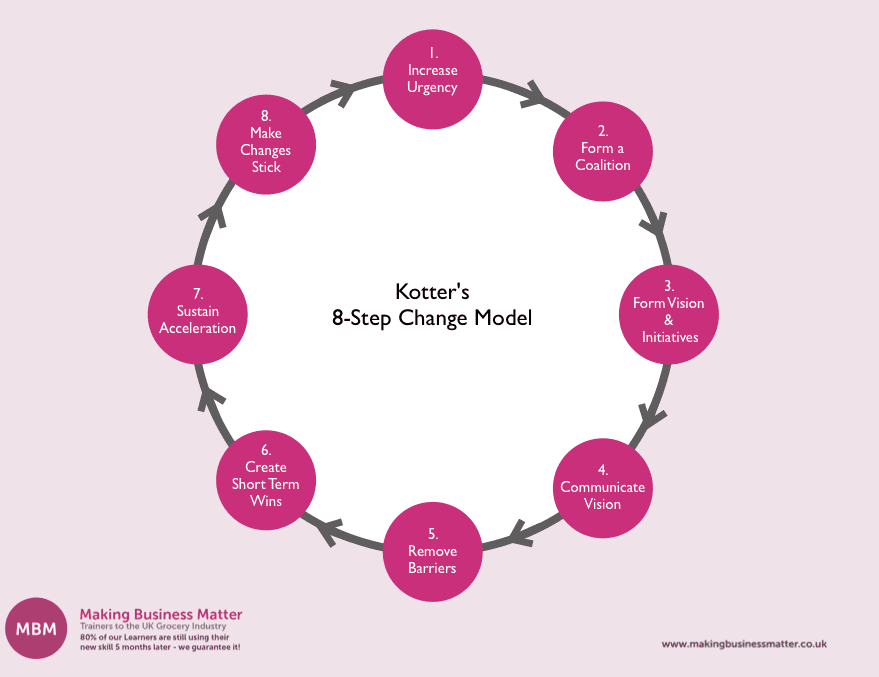
Now this model was developed by John P. Kotter, a Harvard Business School professor, who identified 8 stages relating to change. These stages are:
- Create a sense of urgency: You need the team on your side for change to happen. Therefore, explain the need for the change and why now is the time.
- Build the change coalition: Next, you need to have the right people in place to drive change. Here, select those who will implement and positively impact the process.
- Form a strategic vision: There needs to be a plan. So, work on our action steps and the roadmap for change.
- Communicate the vision: Here, share with the entire team the change process that will be happening, how it will work and what are the expectations. Create clarity and understanding for everyone.
- Remove barriers to change: Answer questions, share possible barriers, and empower those around us to make the change happen. Ensure all possible barriers to success are considered.
- Focus on short-term wins: Recognise and appreciate the successes we achieve along the way. Also, ensure that all progress landmarks are noted.
- Build on the change: Now, keep the momentum going and continue to build on the progress that change is generating.
- Make the change stick: Finally, ensure that the change process now becomes part of the fabric of the company. So, remove anything that could hinder this and bring us back to old habits and ways.
This model is very much a how-to guide for leaders to manage the change process. However, it takes time and effort to put this detailed process into action. Unfortunately, not all leaders are willing to make that investment, even for the right results.
Advantages and Disadvantages
Positive Attributes:
- This is a very thorough model with easy stages to follow.
- The model has been around for years with a proven record of success.
Negative Elements:
- The model can feel overwhelming for some leaders with so many stages to process.
- This process doesn’t include input from the team, which can work for larger companies but can be a barrier for smaller companies.
Model #10: Maurer 3 Levels of Resistance and Change Model

Finally, we have the 3-step model all about focusing on reasons why the change often fails. This is a different approach from other models. Therefore, it looks at the approach to change from a different perspective. the 3 steps are:
- “I don’t get it.”
- “I don’t like it.”
- “I don’t like you.”
Here, the stages are very much about the type of resistance change generates. Use this model when you have a team that can brainstorm the potential pitfalls the change process could bring about. Then, put these ideas into a working model to prevent as many of those from happening as possible. Also, mix this model with others that focus on other aspects of the change process to get the best overall chance of success.
Advantages and Disadvantages
Expected Positives:
- With only 3 steps, it isn’t overly complicated to use.
- It takes a unique look at the barriers to potential successful change.
Possible Negatives:
- On its own, it won’t bring about the action plan or roadmap required for change to happen.
- Unless the team is honest about the potential reactions to change, you will miss out on identifying potential barriers that you want to prevent.
Reasons to Use Change Management Models
As you can see, change management considers the whole business and what needs to change. It also takes into account how people and teams are likely to be affected by their business transition. This is the common factor in the models we explored.
Overall, businesses go through different kinds of change. Change management models help us deal with these changes in more effective ways. Some examples are:
1. Structural:
Here, we see change occurring within the team dynamic. This can be anything from leadership change to restructuring of departments to downsizing. These can have major effects on the business. Think back to the pandemic. This type of change was common for many companies needing to cope with events. Look at possible structural changes that you plan to make. Then consider which model would best deal with the impact this has on the team.
2. Strategic:
Here the change is focused on goals, competition, and market position. The changes that occur revolve around the company’s policies, processes, and operations. This could be a shift in direction with a new mission and values. Or, we might see the processes we use change so we are more productive or efficient. Some can be minor changes that are specific to small teams within the company. Others are company-wide. These tend to be more time-consuming and, at times, challenging.
3. Technological:
Now, the change occurs due to changes happening with technology. System updates, new software, and hardware changes are common here. These can be rolled out with ease, with proper planning and structure. However, these changes do come with their own set of challenges. Remember, not everyone is a tech lover. Therefore, consider everyone in the team and their needs for the change to roll out well.
4. Unexpected Change:
Well, this is pretty self-explanatory. We see change happening all of a sudden, with no warning or proper time to plan. This could be something as simple as a team member out sick at a critical time in a project. Or, it could be something more impactful such as the company losing power for the day and needing to adapt their working style to complete tasks.
All in all, when businesses change, the people they employ go through a transition, too.
Selecting the Change Management Model that Works for You
So, we shared 10 amazing models with you. All have their advantages and limitations. However, now it’s up to you. So, what’s needed now? Action!
First, analyse your current situation. Then, understand what change is required for improvements and growth in the company to happen. Next, see which of the models suits your needs best. Finally, take each stage at a time and plan carefully for every possible outcome, both positive and negative.
Now we are sure one or more of the models we shared with you here will be the right fit for your change management needs. Good luck!
Also, we’re on Linkedin, come and engage with us.
Updated: August 2023 by Ailish O’Rourke-Henriette




